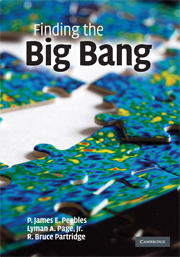2 - A guide to modern cosmology
Published online by Cambridge University Press: 05 July 2015
Summary
The universe is observed to be close to uniform – homogeneous and isotropic – in the large-scale average. That means we see no preferred center and no edge to the distribution of matter and radiation, and what we see looks very much the same in any direction. Stars are concentrated in galaxies, such as our Milky Way. The galaxies are distributed in a clumpy fashion that approaches homogeneity in the average over scales larger than about 30 megaparsecs (30 Mpc, or about 100 million light years, or roughly 1 percent of the distance to the furthest observable galaxies).
Space between the stars and galaxies is filled with a sea of electromagnetic radiation with peak intensity at a few millimeters wavelength and with spectrum – the energy at each wavelength – characteristic of radiation that has relaxed to thermal equilibrium at a definite temperature, in this case T = 2.725 K. This thermal radiation is much more smoothly distributed than the stars, but its temperature does vary slightly across the sky. (The temperature differs by a few parts in 100,000 at positions in the sky that are separated by a few degrees.) The evidence developed in this book is that the radiation is a fossil remnant from a time when our expanding universe was much denser and hotter, and that the slight temperature variations were caused by the gravitational pull on the radiation by the increasingly clumpy distribution of matter in galaxies and clusters of galaxies.
We offer in this chapter a guide to basic ideas behind the interpretation of the radiation. We begin by explaining the concept of a universe that is homogeneous and expanding in a homogeneous and isotropic way. Section 2.2 describes the meaning of thermal radiation and its behavior in this expanding universe. In the concluding section we present a list of the main known forms of matter and radiation in the universe as it is now.
- Type
- Chapter
- Information
- Finding the Big Bang , pp. 9 - 22Publisher: Cambridge University PressPrint publication year: 2009



